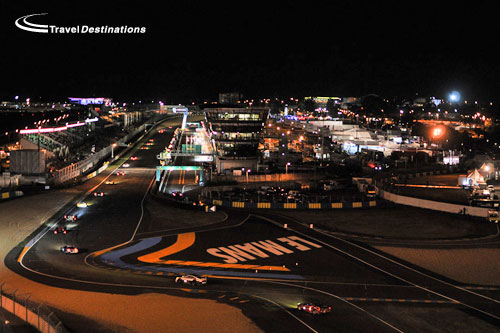The 90th anniversary Le Mans 24 Hours race was a race packed with action, incident and emotion. Indeed, the highs were high and the lows were very, very low.
We would like to remember the 2013 Le Mans 24 Hours as a fine race, one where a great champion won once more, where home favourites finally achieved their promise in class and the drama in the GTE class was enthralling and unforgettable. Sadly, though, it is likely this year’s Le Mans will be remembered for the events of the fourth lap, where one of the most respected and liked people in the paddock lost his life.
A lot has been written about Allan Simonsen’s death and there is nothing constructive that can be added here. Suffice to say that everyone here will remember him for a wonderful attacking driving style, a never-say-never attitude and superb racecraft.
But there are positives to take out of this race – Tom Kristensen won his ninth Le Mans 24 Hours, the race was not the Audi romp that some had predicted and, if we count Matt Griffin (which we certainly do, if only by association), then there was British interest on every single podium. Not only that, but one of Henri Pescarolo’s chassis (ish) finally achieved success at Le Mans, as a Morgan, with Oak Racing.
It was a dramatic week, with a few pretty sizeable incidents before the race even started, and inclement weather that did its best to disrupt every track session.
But it wasn’t a bad race and it was wide open in every class for just about the entire race.
LM P1
From the start of running, one thing was clear – Toyota were off the pace. Not just by a little bit but by enough to make it a long, long race for the Japanese cars. The TS030 looked the part but was seconds back from the ultimate pace of its diesel rival from Audi, the Toyotas hadn’t even matched their 2012 pace for much of the week and one was actually slower than one of the private Rebellion Lolas until the very last session of qualifying.
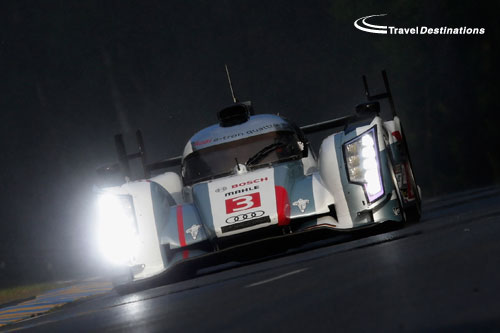
Qualifying itself was a pretty big anticlimax. With tension building throughout Thursday, and the assembled masses eagerly pressing their noses to fences, the session would not actually be faster than Wednesday and Loic Duval’s pole time would come from the previous day. It was a far cry from previous years, when Sarrazin and Bourdais had been bolted into Peugeots with minutes to go and told to make France proud. Still, the gap had closed slightly between Audi and Toyota.
Saturday dawned cooler, a relief from the heavy humidity that had sapped energy from anyone trying to swim through the soup-like air during the week. The usual pre-race clamour at Le Mans was building the atmosphere gradually, with dignitaries and guests packing the grid to get a brief taste of the Le Mans atmoshpere. They were showered by intermittent rain, which wasn’t particularly heavy but just enough to make drivers a little more cautious on what was now a greasy surface.
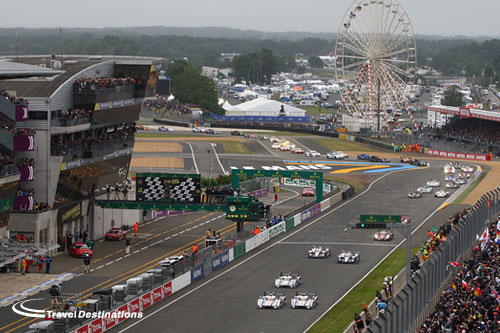
As the cars rolled toward the end of their formation lap to the strains of Strauss’ Also sprach Zarathustra, all 245,000 people drew a deep breath and held it. Every spectator, be they the casual fan, the journalist, the team members, the marshals and the commentators, strained for the best view of the 56 chargers sweep past.
First to sweep through was Andre Lotterer, who got the jump on team mate Allan McNish to pass around the outside of the first turn and take the lead of the race. Behind them, Nico Lapierre was already making strides to put his Toyota in the mix. He would keep his charge on, passing McNish into the first chicane, seeing him get the place back on the exit and then make a stupendously brave move around the outside under braking for Mulsanne Corner. Pressuring as best he could, he was soon attacking the leader.
Behind the leading trio, Davidson was having a great battle with di Grassi in the third of the Audis, the Brazilian’s diesel Audi ending the lap fifth behind the Toyota. You would’ve been laughed out of Le Mans if you’d said the order would be #1-#7-#2-#8-#3 at the end of lap one…

The five works cars were swapping places merrily and getting a pretty good hustle on when the safety car emerged for Simonsen’s accident. It would be the first of many safety cars (“I drove six hours, and four of them were under safety car,” said Allan McNish), and it would last pretty much an hour.
When the race settled down, it developed a rhythm – the Audis were faster, the Toyotas could go a little bit further. For the Japanese cars, it was looking like it just wasn’t enough – they were going to need uncharacteristic problems for Audis if they were going to win this race.
Those problems came in the seventh hour, for both the leading Audi #1 and the #3 car. Coming under the Dunlop Bridge, the #3 suffered a puncture and had to limp the entire lap round. It did so and rejoined, but would then have to return to the garage to repair damaged bodywork. The resulting delays put it behind the Toyotas and effectively out of contention for victory.
For #1, the problems were even more serious. It was wheeled into the box, where the rear was taken apart in the search for an electronics problem. Bizarrely, the car was rocked back and forth on its stands by the Joest Racing crew, but as the seconds ticked by it became clear that Benoit Treluyer, Andre Lotterer and Marcel Fassler were not going to win their third consecutive Le Mans 24 Hours.
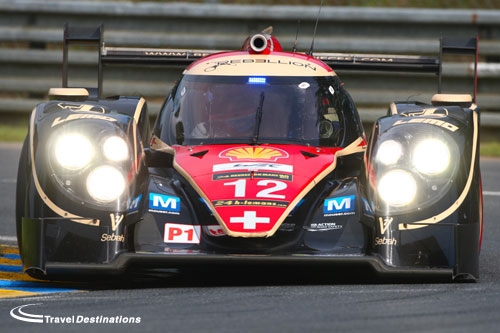
They would lose 12 laps or just about 40 minutes changing an alternator, and eventually rejoin so far back that any hopes of a victory were lost. For the record, though, they only finished ten laps behind in fifth place.
Just like in 2011, then, Audi were left with one bullet in their gun and a whole team of opposition cars chasing them. And, just like in 2011, they were strong enough to hold off that challenge. When the rain came every now and again, they had slightly less advantage – arguably, Toyota were faster in mixed conditions – but they didn’t panic and simply stayed on track and ran consistent laps out of trouble. And though the TS030 was clearly more economical than the e-tron, they got around that by simply driving faster.
The #8 Toyota was fast but at no point as fast as the leader and there were a huge number of safety car incidents that neutralised the Audis pace advantage each time. Loic Duval, certainly, was not running at his absolute maximum and the logical thing to do if you have an advantage is to keep your opponent and arm’s length and take as little risk as possible. In a race that was already treacherous thanks to the mixed weather and traffic, it was an approach that made sure of victory.
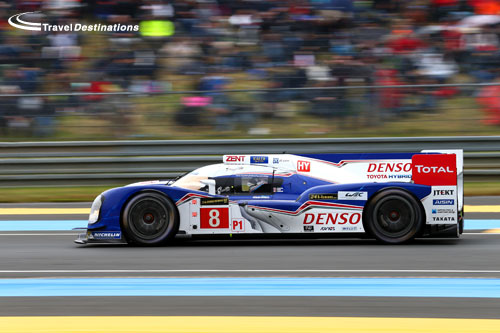
As the race progressed #2 in the lead stayed roughly a lap ahead of #8, while #7 Toyota ran for a long time swapping places with its team mate, before an inspired stint from Buemi in another greasy wet hour of the kind that typified the race broke the challenge and the #8 went clear.
Toyota even looked like they might be able to score an unlikely double podium (some had not given them a prayer of this against three strong Audis) until Lapierre was unfortunate enough to lose the rear of his car at the Porsche Curves just as rain began to fall. He was pushing hard racing the recovering #3 Audi, which was moving into third every time the Toyota pitted. A heavy nose-first impact looked to have put the car out of the race before the Frenchman limped to the pits to be repaired and make the finish in fourth.
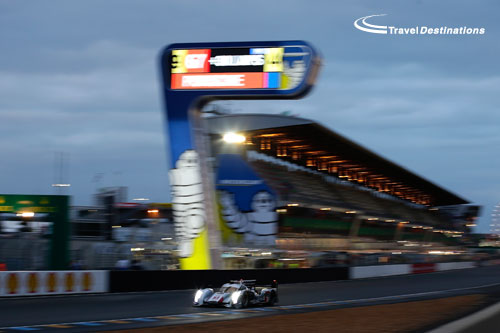
In the final hour, #8 briefly regained the lead lap after a massive downpour brought out the safety car. But with fuel looking marginal if he would make the finish without stopping, Buemi deemed it best to cede the lap once more and finish one lap down, meaning he would have to do one less lap. He would’ve needed a miracle to win, anyway.
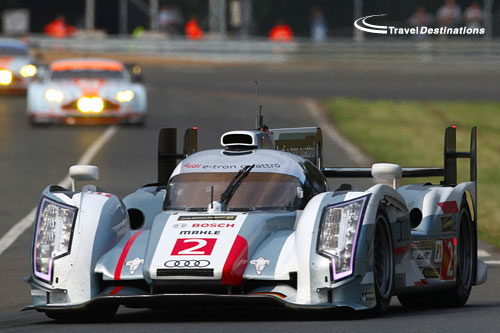
So Mr Le Mans is now ‘Mr Le Mans, 9 times’. His team mate, Allan McNish, took his third win and Loic Duval, who had been the fastest Audi driver all weekend and recovered beautifully from his big accident at the test day, his first. But it will be hard hard to think of the race without remembering Tom Kristensen’s tears on the final lap, or those he shed in parc fermé, or the way he kissed the Danish flag on his helmet after raising his eyes to the one flying half mast on the podium. He, and many others, lost a friend but at least he did #winitforallan. A fitting end.
LM P2
The LM P2 race was an odd one. What had looked like a competitive field pretty much bowed to the might of OAK Racing, whose Morgan Nissans finished one-two and seemed pretty comfortable from quite early in the race. The #35 car, with Bertrand Baguette, Martin Plowman and Ricardo Gonzalez, ran out winners by a lap, with their team mates Olivier Pa, Alex Brundle and David Heinemeier-Hansson second. G-Drive’s ADR run #26 with Mike Conway, John Martin and Roman Rusinov was a further lap back in third.
Certainly, things had looked different. That the Nissan was the motor to have was obvious, with all but seven cars in the class using the engine. But there was variety at the head of the field in qualifying, with none of the first four cars sharing the same chassis/engine combination. Pole went to Olivier Pla – one of the few movements in the final qualifying session on Thursday.
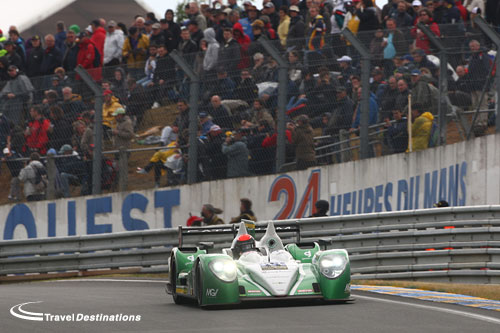
At the start, the action was beyond frantic, the cars nose to tail for lap on lap – a quite ridiculous sight that was largely missed on TV. That is not the fault of the TV director, who had a very difficult job juggling fantastic battles in every class. Until that fateful early safety car, the battle raged.
Pla held the lead, with John Martin for G-Drive tucked under his rear wing. Those two had a small gap over pretty much the rest of the field, who were almost touching – no room for error in such a tight field.
As the safety car emerged, so a couple of P2 cars hit trouble. While their #26 was second, the #25 Delta-ADR run car was into the garage with Shinji Nakano onboard, with problems. Also pitting were Murphy Prototypes. Their Oreca had an electrics problem and would lose a lot of time under the first caution.
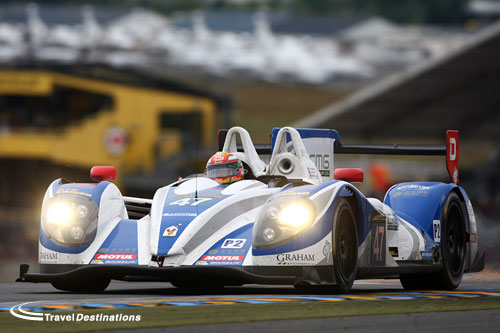
After the safety car, and subsequently the first round of stops, OAK Racing found themselves in one-two formation. Olivier Pla was leading (and flying) with Bertrand Baguette just as fast in second place. Pierre Kaffer was third for Pecom, but not really in touch with the pace the two leading Morgan-Nissans could produce.
It seems amazing to say ‘and the top two pulled away, then briefly battled, then settled’, with the field on show. But that was the story of the race. The lead changed when, in the sixth hour, Heinemeier-Hansson spun viciously at the Porsche Curves (in front of the race leading Audi) and nerfed the tyres. Remarkably, he escaped undamaged but a trip to the pitlane to inspect the car put them behind the #35.
After that, the pace of Baguette was just too strong – his laps enough to fend off the chase of team mate Pla, a surprise with the previous form and experience of the two drivers. It was remarkable also, to see that the OAK team suffered no more reliability issues with their top two cars – though their #45 would suffer a few issues and eventually succumb to retirement soon after being punted into a spin in pitlane by an AF Corse Ferrari.
Through the night the order behind them shuffled, with some impressive times appearing from the two Zyteks still in contention – #42, with Jann Mardenborough on board, was showing a bucketload of form while Jota’s #38 was matching with Oliver Turvey. However, to think that Mardenborough is an ex-gamer, while Turvey is an F1 tester, is remarkable.
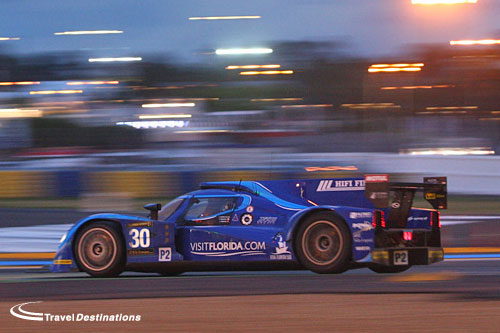
Still, they couldn’t match the #26, which held third despite a couple of small delays and would do so until the finish. It was a car stacked with pace, particularly in the hands of Mike Conway and John Martin, but the Oreca chassis doesn’t quite have the same suitability that the Morgan does for Le Mans.
And thus it was that OAK Racing won the class comfortably one-two. They had a better package – the car, the team and the drivers were faultless bar the small accident for DHH and that’s why #24 finished second. Otherwise, there was nothing to choose between them.
G-Drive by Delta-ADR were third and would have won in many years past. They had a strong driving team, good pace and pretty solid reliability – bar issues with their light up door numbers – but weren’t quite on the level of the pink and black cars.
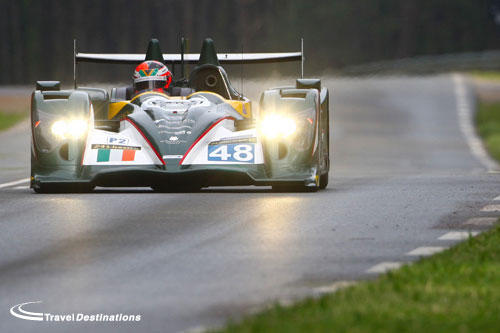
That Greaves finished third with Krumm-Mardenborough-Ordonez is probably a disappointment to that squad. Krumm has proven pedigree, as has Ordonez and Mardenborough proved his at the event. But circumstances conspired against them and they were caught under the wrong safety car a few times and ended up off the podium.
The other Zyteks both suffered – #38 had an accident with Luhr aboard that damaged the front, while the #41 Caterham liveried Greaves car had a series of suspension problems that cost them too much time to recover.
For Lola, it was a Le Mans to forget in LMP2. Their three cars were all out of contention for victory, and only one finished. The Gulf Middle East car was in trouble right from the start, spending a vast amount of time in the garage before returning for one tour and eventual retirement. The HVM car suffered still further, a huge accident in the Porsche Curves with Tony Burgess onboard ripping the rear off the Lola but remarkably the Canadian stepped out and walked away.
The DKR car suffered quite a bit – it was never on the pace (running in the GTE Am ranks for much of the race). It also struggled in traffic, causing issues for those around it at times. They will be pleased to simply have made the finish.
The first non-Nissan home was the Morand Racing Morgan Judd, who had a very quite race with the Morgan-Judd, but the other Morgan in the running was not so fortunate. KCMG’s Nissan powered car looked strong (particularly with Alex Imperatori driving) but suffered various delays and eventually stopped for good with a fuel leak.
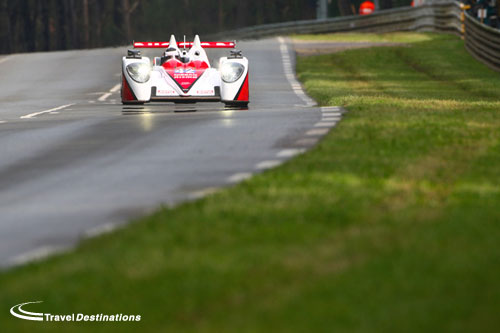
Of other note were Race Performance, tenth with Nürburgring 24 winner Jeroen Bleekemolen amongst the squad in their Oreca Judd, and Murphy. The Irish team ended the race seventh after a remarkable comeback from drama with Mark Patterson, Karun Chandhok and Brendan Hartley sharing the wheel. Their Nissan powered Oreca had flashes of strong pace but, even with a clean run, it seems unlikely they would’ve been able to match the all conquering OAK.
While one G-Drive/ Delta-ADR was third, the other failed to finish. Early problems had scuppered them but they were undone later by a crash (for the second time, after an accident in the warm up) for Tor Graves at the Porsche Curves. The only other Oreca not to finish was the Thiriet by TDS car, which spun in a late race downpour while running well and was withdrawn by Pierre Thiriet with too much damage.
Boutsen-Ginion were slow, but consistently so, and did finish – but well down. Signatech’s Alpine Nissan, meanwhile, showed strong pace after an early accident caused them delays and they finished ninth.
HPD had a race, largely, to forget. The #33 of Level 5 Motorsports struggling for pace and was also ultimately unreliable, stopping a while before the finish before being wheeled out to cross the line unclassified with a final lap.
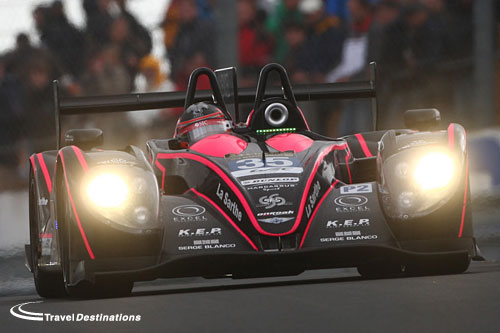
So finally, OAK won – having delivered on promise they’ve shown for many years. It was their first ever FIA WEC win (remarkably) and it can only be hoped they’ll continue this momentum forward, because they richly deserve more success.
GTE Pro
The factory GTE battle was a race long dogfight but the main protagonists of recent years, the corvettes and Ferraris weren’t in contention for overall honours this time as the Vettes just lacked the required pace and the AF Corse Ferraris had just too much trouble and not quite enough speed.
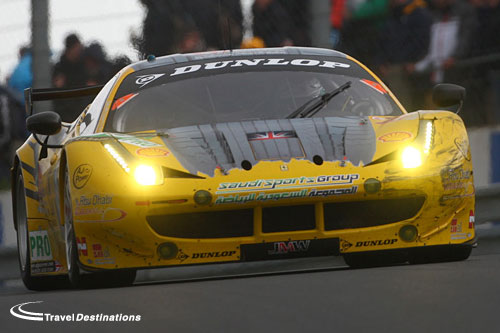
The two SRT factory run Viper GTS-R’s were popular Le Mans debutants and whilst they need a lot more race pace they did feature one of the bravest drives of the race as the European crewed #53 Viper saw a distraught Dominik Farnbacher drive on despite knowing of the death of his close friend Allan Simonsen – Truly a GTE Pro.
Corvette Racing have always battled at the front, whether in GT1 or latterly GTE and their lack of competitive edge this year frustrated and bamboozled the team, their drivers and their legion of fans.
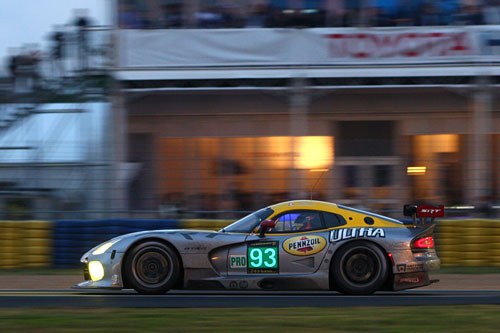
Attrition for others saw the best of the Vettes, the #73 of Jan Magnussen, Jordan Taylor and Antonio Garcia finish in fourth place in class, the highest of all the ALMS runners.
Next up in the finishing order were AF Corse’s pair of battle scarred Ferraris AF Corse with too many off track moments, too much contact and not enough pace to put the Italian Stallions in amongst the leaders after the early running.
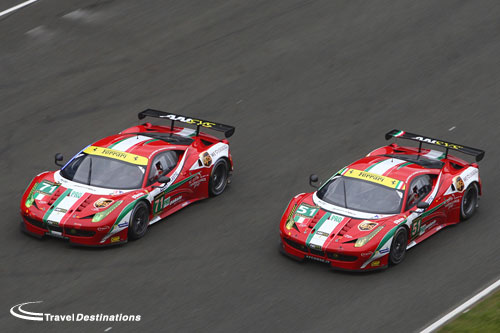
That left the real contenders as the two car factory Porsche effort vs the three car Aston Martin racing team – 50 years of the 911 vs 100 years of the famous British marque – History Boys all with the additional emotion of a deeply upset Aston Martin Racing team, racing on in memory of their fallen team-mate at the specific request of his family.
Whilst AMR’s #98 Vantage was never in overall contention the sister #97 and #99 Astons most certainly were!
The two Vantage V8 GTEs heldtwo of the top three spots for much of the race until Fréd Makowiecki made a rare mistake in the wet conditions towards the end of the race, sliding off the track on the exit of the first Mulsanne chicane, destroying the front of the car and finishing a fine run on the spot.
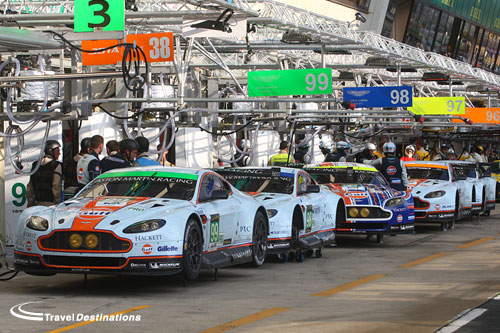
The Gulf ‘Art Car’ #97 then was the last bullet in the Aston gun after battling back after an extra stop to replace a faulty lit number panel.
Darren Turner, Stefan Mücke and Peter Dumbreck were right there in contention until a late race downpour brough strategy, and as things would turn out, racing luck, to the fore.
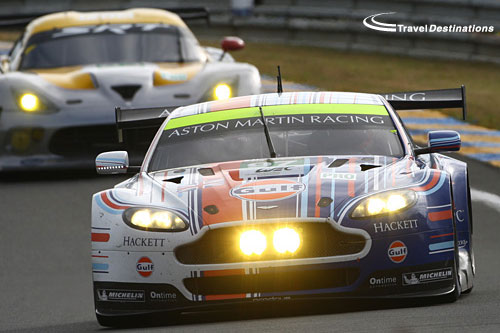
Both team’s gambled on tyres during the time spent behind the final safety car, and the British squad, having not missed a beat in over 23 hours, simply made a single wrong call. The heartbroken team finishing third after what, at times, had looked like a certain one-two.
Porsche then came home in an unexpected 1,2 – Lieb, Lietz and Dumas the famous three in 2013. The factory 911s had, after all, had class leading pace, and were rock solid reliable too. 15 years on they’d won again on their return as a factory outfit – Who’ll bet against that success coming in overall win terms in 2014?
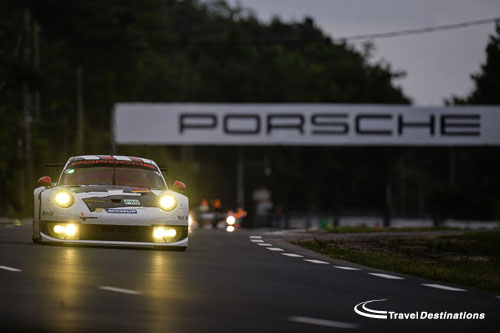
GTE Am
The healthy list of Am runners in this year’s race had all the ingredients needed for an exciting 24 hour long skirmish between a variety of teams and chassis. The eventual winners would be the #76 IMSA Performance Porsche 997 RSR of Ramon Narac, Christophe Bourret and the extremely impressive Jean Karl Vernay in a race that will however forever be remembered for the tragic loss of Allan Simonsen after the much loved Dane lost control of his #95 Aston Martin in avoidance of a spinning car early in the race. The polesitting car was leading the class race by a country mile at the time of the accident – RIP Allan Simonsen.
With the clear favorites out of the race early, IMSA Performance would dominate many of the remaining hours, winning a class at Le Mans for the first time since 2007, and doing so in style with a lap in hand. Their main competition was just never quite quick enough and left the fans wanting more.

8Star Motorsports came into La Sarthe’s big race fresh from a well earned victory at the WEC round at Spa. Looking to continue the momentum they qualified a disappointing eighth in class and never really featured.
Fellow US based Ferrari runners Krohn Racing were another team that had a tough run.
Team Owner Tracy Krohn had a massive off in Friday qualifying, destroying their car and forcing them to rent a car more usually seen in the Superstars GT Sprint Series in Italy.
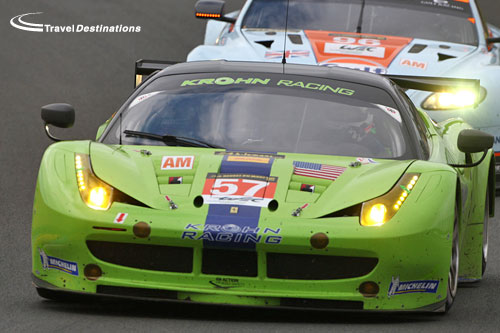
The car was completely rebuilt to LM GTE-Am specification but the huge effort expended came to nought with a further costly error from the team owner during the night which would damage the car again, a bad end to a bad weekend from the team in green..
The sole remaining Aston Martin in the class also struggled. It looked to be in the fight for a podium, but Stuart Hall and Jamie Campbell-Walter just couldn’t overcome an early delay. Despite good speed from the two Pros on the team the #96 car came home just shy of the top five.
Larbre Competition were looking for a class win for the fourth year in a row, and in truth it never looked even an outside possibility.
The #70 entry of Cooper MacNeil, Manuel Rodrigues and Philippe Dumas suffered clutch trouble after an off for the American. The #50 car had a less troubled run, but there just wasn’t enough pace this time from Jack Leconte’s team – Another winning run bites the dust.
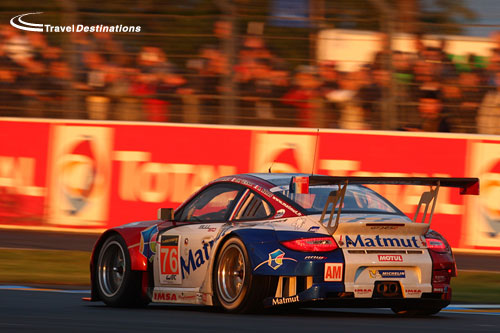
Ultimately it came down to the #61 and #55 AF Corse Ferraris, the Dempsey Racing Del Piero Porsche and the winning IMSA entry. The main Proton entry – the #88 – should have featured but was a victim of Romain Brandela’s major lapse of concentration in the early hours of the morning, forcing Paulo Ruberti off the circuit at the Dunlop Esses and damaging the car at the point where Proton were at their strongest and running in second place.
The Dempsey del Pietro Racing (with Proton) squad proved to be a real force, the car leading well until the TV heartthrob was bundled into a spin by a passing LMP runner.
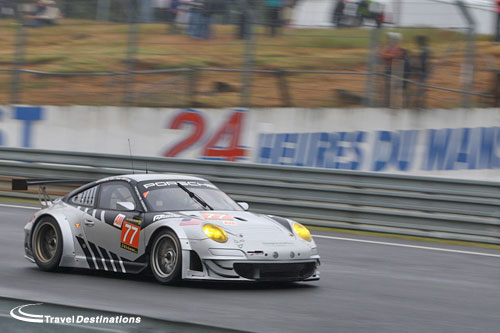
That caused a lengthy delay – But that was the starting gun for an epic run Porsche factory driver Pat Long, the American fighting over a podium spot with Matt Griffin in the #61 all the way to the flag – the deciding factor in the Ferrari’s favour being an unlucky safety car position which cost the Porsche almost two minutes.
AF Corse’s efforts were therefore rewarded as the #55 and #61 cars finished second and third in class respectively. A few niggles left them with little chance of beating IMSA and instead fending off the hard charging Dempsey team, but they were left satisfied with their end result. Griffin though would save the podium celebrations for another year as he mourned his long-time British GT sparring partner Simonsen.
IMSA Performance welcomed this, as they quietly controlled the race from the front. Vernay in his debut was the star of their #76 entry though, as he lapped unbelievably fast in the tricky conditions, making a case for a future position in the Porsche organization. The local, loyal French team took a deserving win at Le Mans, it’s just a shame that one of their big defining moments came at such a difficult time.
Written by Jake Yorath and Graham Goodwin
Photographs: Dailysportscar.com

